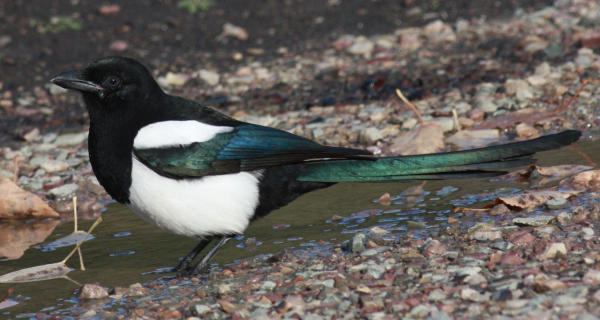
Black-billed Magpie
|
Peter began this week’s visit: Hola, Paul! This time of the year in South Carolina, some of my best birds are backyard “fly-overs.” My German shepherd rouses me at 6:00 every morning to throw the ball for him, and the bonus is lots of early bird activity. Our home is surrounded by woods, but we have plenty of open sky overhead.
Almost every morning one or two Purple Martins fly over. I always hear them before seeing them. The blackbirds have started flocking, and it’s not unusual for a flock of a dozen Common Grackles or Red-winged Blackbirds to pass over.
There are lots of small ponds in the surrounding countryside and I see a fair number of wading birds as they move from wetland to wetland. Small flocks of Cattle Egrets are common, and often one or two Little Blue Herons pass by. Great Blue Herons and Great Egrets can also be seen, almost always one at a time. Formations of White and Glossy Ibis are rare, but I’ve recorded both. The best sighting by far was a group of 22 Wood Storks that flew over, not much higher than treetop level. Our local Audubon Sanctuary manages ponds specifically to provide foraging habitat for Wood Storks, so it’s not too surprising that they are in the neighborhood.
When the shepherd gets tired of chasing the ball, we sit on the grass in the backyard and just watch the sky for birds. It’s a great way to start the day!
Paul replied: Hey Peter, I enjoyed your Idaho birding description in the last issue so much that on a beautiful sunny day this week, I turned my van west and drove cross-state to the Badlands – to Theodore Roosevelt National Park to be more specific. It’s been such a green spring that I wanted to see the Badlands landscapes at their best and see what western birds I could find.
As I descended into the Little Missouri River Valley I began seeing western species that I don’t see in my neighborhood: Golden Eagles, Black-billed Magpies, Spotted Towhees, Rock Wrens, Townsend’s Solitaires and Say’s Phoebes – what fun. And they were mixed with other birds I don’t regularly encounter, including Bank and Cliff Swallows, Eastern Bluebirds, Yellow Warblers and Turkey Vultures.
A couple memorable sightings stand out: A female Northern Harrier diving at a Golden Eagle as it soared along the edge of a steep Badlands cliff; adult Rock Wrens feeding two fledglings on a wind-carved sandstone outcrop; and an American Kestrel in flight holding unusual prey in its talons – a small snake – with a Western Kingbird diving at the mini-falcon on the wing.
An interesting aspect of this region is that the mighty Missouri River is the great divider of the Northern Great Plains, as well as the state of North Dakota. Located halfway between my home and the Badlands, it’s always interesting to see how the avifauna changes on the west side of the Missouri River. Spotted Towhees replace Rufous-sided Towhees, Black-headed Grosbeaks replace Rose-breasted Grosbeaks; Lazuli Buntings are found in the west, Indigo Buntings to the east; Say’s Phoebes are found west, Eastern Phoebes to the east. Even Bald Eagles are mostly usurped by Golden Eagles in the west.
Closer to home, more duck broods are hatching each day and orioles continue to add excitement to the feeding station outside my bay windows, but I’ll give you a detailed update on these local birds next week. In the meantime, I hope everyone has an opportunity to search for some different birds, across town or cross-country; but foremost, enjoy your summer!
Paul Konrad and Peter Stangel are the editors of The Birding Wire. Share your recent birding experiences and photos with Peter and Paul at editorstbw@gmail.com